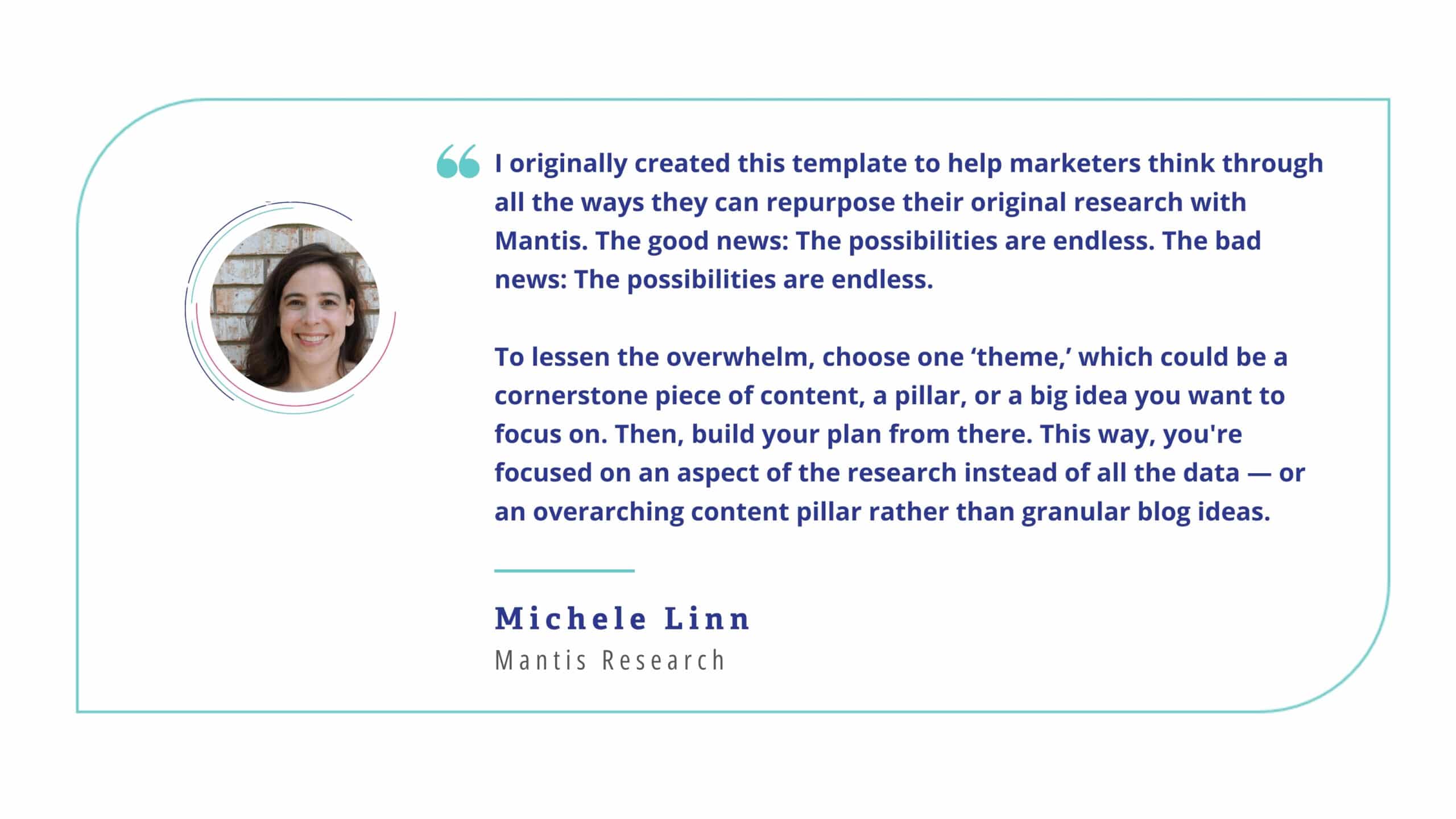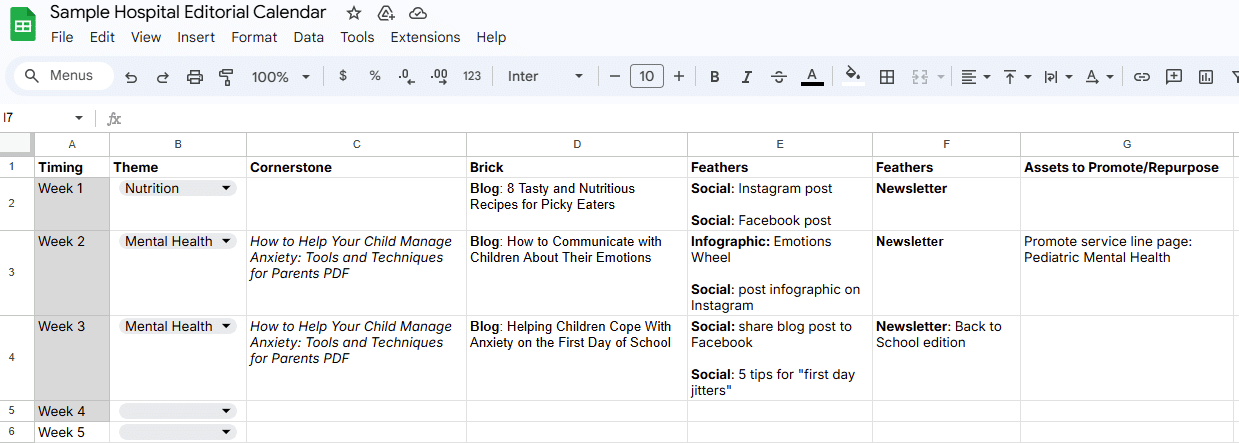What is an editorial calendar?
Every day, healthcare marketers juggle a variety of content formats, channels, and topics. Tracking that much content — from who writes it to when it gets posted to how well it performs — can be overwhelming or even impossible without an organized process.
Enter: The Editorial Calendar.
Editorial calendars, or content calendars, are governing documents that organize your content efforts. Most editorial calendars lay out content topics and formats across a period of time. They’re organized by week, month, or quarter.
How does an editorial calendar help?
Basic editorial calendars outline topics and deadlines to keep a team on track. But sophisticated healthcare editorial calendars do so much more.
An editorial calendar can help you:
- See the big picture: Planning multiple weeks of content at once allows you to zoom out and understand your greater content ecosystem. What topics do you cover, and how do they connect? What’s missing? What is and isn’t performing?
- Align your team: Siloed content teams are a recipe for disaster. You don’t want to hit readers with a slew of random articles and posts — you want to deliver a cohesive content experience. When your team members know what’s on deck in your content plan, it’s easier for them to work together and deliver on your goals.
- Delegate: Imagine swapping out 15 emails at the start of the week with one central resource that everyone can view and act on. Healthcare editorial calendars reduce the communication load on marketing managers and content leads — giving you more time for higher-impact hospital marketing tasks.
- Get more mileage out of content: An editorial calendar encourages you to bring new life to existing assets and repurpose content in new ways. Yesterday’s white paper can become half a dozen blog posts.
- Focus on what matters: It’s easy to get caught up in the content merry-go-round, lose sight of business objectives, and publish just for the sake of it. Editorial calendars stop “random acts of content” and help you think critically about the purpose behind each piece of content.
How to create your editorial calendar
Wondering how to start creating an editorial calendar or looking to spruce up your template?
No editorial calendar is perfect for every healthcare marketing team. We’ve worked with over 150 hospitals, and each one follows a different content process.
You wouldn’t give your grandma’s chicken parm recipe to your vegan friend. Likewise, don’t expect another hospital’s editorial calendar template to work for you as-is. Be open to experimenting with calendars until you create something that works for your team.
Here’s a place to start.
Step 1: Choose your calendar template
You could build your editorial calendar from scratch … or you could learn from others and adapt an existing template to save time (and heartache). Think smarter, not harder, right?
This is the editorial calendar template we recommend for most healthcare marketers.
Editorial calendar template for Google Sheets
After about 2 decades in the business, we’ve seen some robust editorial calendars. Michele Linn at Mantis Research created one of our favorites — and gave us permission to add our personal touch and share it with you.
Check it out in all its glory. [Click to open the template in Google Sheets.]
The “Start Here” tab provides directions for getting started. But stick around here for a step-by-step explanation of how to create and use a content calendar like this one.
Step 2: Identify your content pillars
Now that you have an empty editorial calendar staring back at you, where do you begin?
Here’s what Michele recommends:
Write down your content pillars — or create them. (Need help with this? Let’s work on your omnichannel content strategy together.)
Step 3: Document your content strategy
Don’t stop with your content pillars. Now’s the time to document other aspects of your content strategy, such as your content formats and distribution channels.
Listing all your content strategy “ingredients” in one place makes it easier to plan a dish. Nothing’s worse than a blank screen (or an empty fridge).
Step 4: Start with themes and cornerstone content
Themes, pillars, whatever your team calls them — begin assigning them to your calendar. You might focus on one theme for a week, month, or quarter. Or you might have multiple themes running at once. (Remember, there’s no one right way to do this.)
As you select the themes you’ll focus on, think about cornerstone pieces of content you’d like to create.
Cornerstone content is a large content asset that can be repurposed and broken down into several. For example, an original research study, webinar, or white paper.
You don’t need to plan cornerstone content for each theme or week. This framework just helps you plan content with the intent of repurposing and distribution.
Step 5: Plan your distribution pieces
In our editorial calendar example, we call distribution pieces “bricks” and “feathers.”
- Bricks are long-form pieces of content, such as blogs or ebooks, that come from your cornerstone piece or stand alone.
- Feathers are short-form pieces like social posts or newsletters.
Again, you can Call [Them] What You Want — but no content plan is complete without ‘em. Readers won’t always seek out cornerstone pieces of content from their favorite health systems. Sometimes, your content needs to find them (on search engine pages, in their inboxes, or on social feeds).
Example editorial calendar for healthcare
What could a hospital’s editorial calendar look like when all the pieces come together? See an example:
Want help adapting this editorial calendar template for your organization — or building one from scratch? Reach out to learn how we build content workflows that make content planning easier.




